I picked up an extension cord today, and I noticed that it had a different value for its wattage and its ampage, based on whether the cord is wound around its base or not.
(I apologize that the picture is blurry. In the left box it says, ”Max current wound - 4 Amps (960 Watts),” and in the right box it says, “WARNING - Max current unwound - 13 Amps (3120 Watts).”)
- Why does this make a difference? Assuming that the wire is properly insulated, shouldn’t it transfer the electricity just as efficiently wound as unwound?
- Is there a formula that I can use to calculate a cord’s wattage/amperage when only part of it is wound, or when all of it is wound, given its wattage/amperage when straight, how much of it is wound, and how tightly it’s wound, and maybe some other variable I can’t think of?
Obviously my question assumes that it has nothing to do with a liability concern or the like.
